The tarantula is a famously large spider. Their size, eating habits, and general lifestyle are fascinating to arachnid-lovers worldwide.
Tarantulas vary in size, ranging from 1 to 4 inches. Their legs can grow from 3 to 10 inches long. The largest tarantula is the Goliath bird eater with 10-inch legs.
This article explores the different sizes of tarantulas, highlighting specific spider species. Keep reading to learn more!
Charteristics of Tarantula
Like all other spiders, tarantulas have eight legs. However, they are a bit more hairy than other spiders.
This hair is known as urticating hair and is used for defense. They irritate the enemy when the spider throws them. The hairs, which irritate predators, play a significant role in tarantula survival.
Most tarantulas feed on insects. However, the bigger ones can feed on small mice, birds, lizards, and frogs. They hunt by sneaking up on their prey, pouncing, and using venom to disable their victim. Toxic enzymes liquefy the prey, allowing consumption.
There are over 800 species of tarantulas globally. Tarantulas live in most parts of the world, including Africa, North America, Asia, Europe, and South America.
Their habitats vary. Typically, spiders survive in rainforests and deserts. Some prefer living in trees, while others build and protect burrows using a web.
Tarantulas shed their skin in a process called molting. This happens more often when they are younger. Once they reach adulthood, the molting occurs yearly and may not happen for males.
The intensity of their venom also varies. However, these spiders are often not dangerous to humans. Most species’ venom is as minor as a wasp’s bite. For this reason, tarantulas make great pets.
What Determines the Size of Tarantulas
Generally, tarantulas’ size depends on the species. However, age makes a huge difference in size. On average, tarantulas are 4.5 to 11 inches. Many tarantulas kept as pets tend to be between 5 to 8 inches. Not many people are interested in keeping the smaller species as pets.
Size information is vital when deciding which type of tarantula you want, as is age and longevity.
The General Size of Tarantulas
Tarantula size refers to the measurement from the front leg to the back leg.
Some tarantula species are fast-growing — particularly the Honduran curly leg species. Depending on the subspecies, most tarantulas take two to five years to reach adulthood.
Knowing the size of the tarantula helps you know which enclosure to buy.
Understanding Tarantula Sizes
Some spiders have a larger leg span than others. For example, the Goliath bird-eating tarantula often has a leg span of 11 inches!
Different Pet Tarantula Sizing
The large Goliath spider is not usually kept as a pet. Most pet spiders are between 5 to 8 inches. Below are common pet tarantulas likely to be chosen by homeowners:
Mexican Red-Knee Tarantula
This popular tarantula is named after its characteristic red legs with black tips. They are one of the best tarantula pets because they are docile and calm. Be sure you’re up for the commitment before purchasing, as females can live for two to three decades!

©Vladimira Pufflerova/Shutterstock.com
Mexican red-knee tarantulas are average sized. They measure between 5 to 8 inches at maturity (about the size of a soda can).
As the name suggests, these tarantulas are native to Mexico. They thrive in tropical deciduous forests, deserts, and dry forests.
Chilean Rose Tarantula
The Chilean rose is the other beginner-friendly tarantula that does not cost much. With 20 to 60 dollars, you can begin your tarantula-owning experience. On average, this tarantula species is considered smaller than many. In most cases, adults measure between 4 to 5 inches.

This close-up image of a Chilean rose tarantula shows the urticating hair.
©iStock.com/warren farnell
The Chilean rose tarantula comes in varying colors. Rose-colored browns and light tans are the most popular colors. Generally, this species is among the most calm and docile, though it doesn’t like to be handled often.
If you are looking for a low-maintenance tarantula, this is a good option. These hardy critters need very little space and can do with infrequent feeding and watering. Additionally, they are not sensitive to heat changes.
Interestingly, these submissive tarantulas enjoy moving objects around their enclosure, including sticks, rocks, and leaves.
This tarantula does well in deserts and habitats with shrubs. It is native to Chile, Bolivia, and Argentina.
Mexican Red Leg Tarantula
Anyone wanting a tarantula that will be with them for years should consider getting this docile species. Males can live up to eight years, while females can live for up to 30 years!
However, you want to be careful when handling and avoid provoking them.
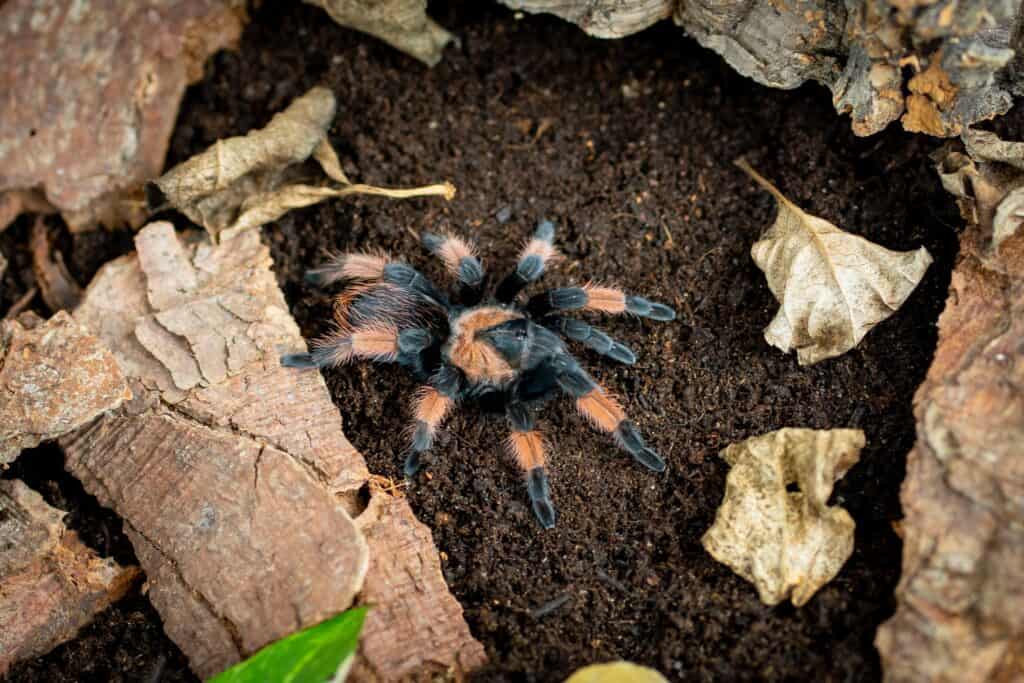
Mexican red leg tarantula measures approximately the size of a dollar bill.
©tempisch/Shutterstock.com
The Mexican red leg is of medium or standard size. It measures 5 to 6 inches across, approximately the size of a dollar bill. Limit handling to only when necessary. When threatened, they can bite and release hairs that irritate. They prefer solace and are often very quiet.
You can easily find this tarantula species in Western Mexico. The Mexican red leg is a ground-dwelling tarantula species.
Pink Zebra Beauty Tarantula
This is another tarantula species known for its longevity. It can survive for 25 years in captivity. Most people choose the pink zebra beauty because of its docile temperament.
It is known to be slow-moving and tolerant. Therefore, it’s an excellent choice for beginners.
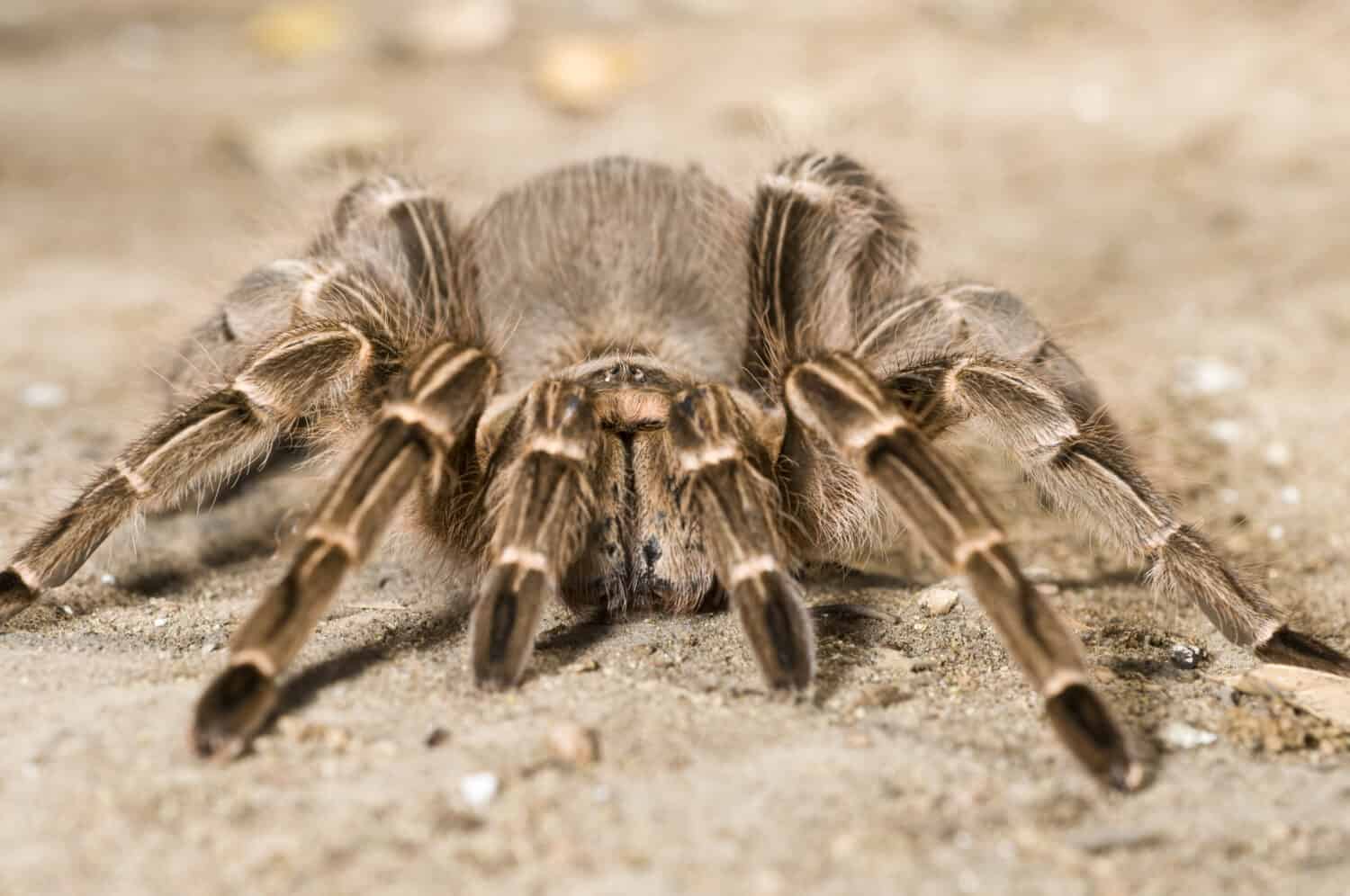
Pink zebra beauty tarantulas get to 5.5 inches when they are mature adults.
©NatalieJean/Shutterstock.com
They have a distinct appearance with a dark brown color and yellow stripes. Some can have a leg span of 6 inches.
The species thrives in tropical and subtropical savanna and grasslands. It is native to Paraguay, Brazil, and Argentina.
Brazilian Black Tarantula
Brazilian black tarantulas stand out for their velvety jet-black appearance. It is often called a black lab because of its docile nature.
Despite its huge size, it is among the best beginner-friendly tarantulas. The 7-inch spider is one of the most popular spider pets.
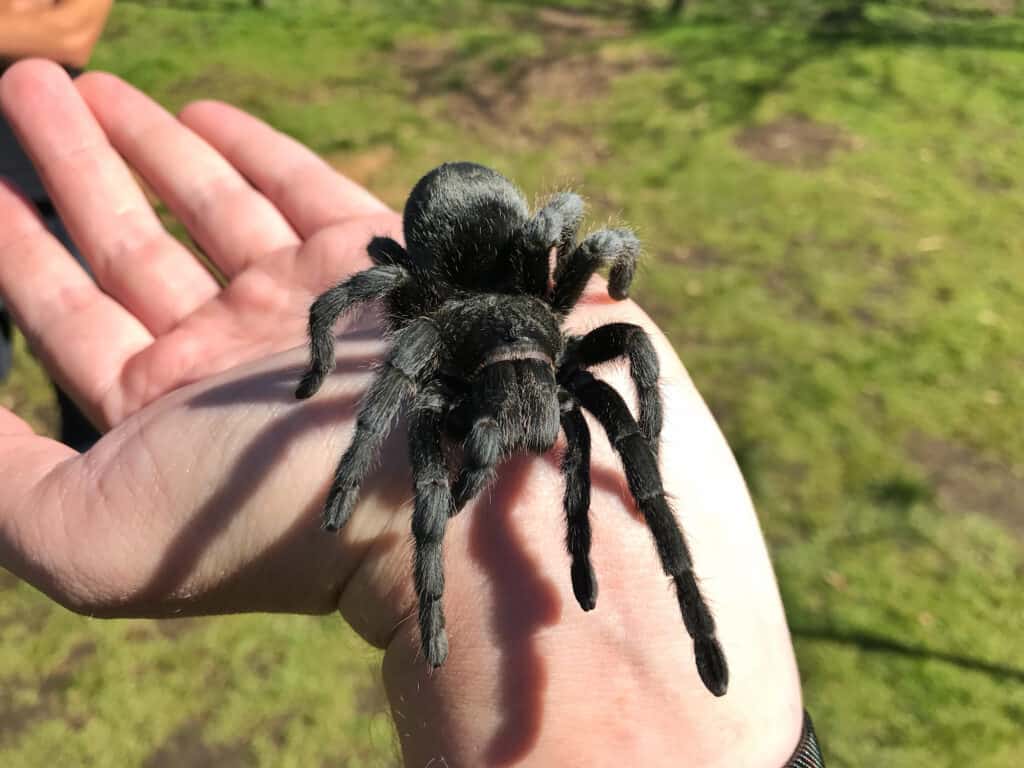
The Brazilian black tarantula is the size of about two credit cards.
©iStock.com/Willem Van Zyl
The Brazilian black tarantula females can live up to 20 years, while males only live for five years. Besides that, they can take up to eight years to mature into adults. Unfortunately, due to their popularity, they cost a decent amount.
In the wild, these tarantulas burrow deep into the ground to make their home. They thrive in the grasslands of Uruguay and Brazil, where their foods are available in plenty. They feed on small lizards, giant insects, mice, and crickets.
Arizona Blonde Tarantula
This tarantula goes by the Mexican blonde and western desert tarantula.
Its habitat is limited to the Arizona desert. Sometimes, it can be found in Mexico.
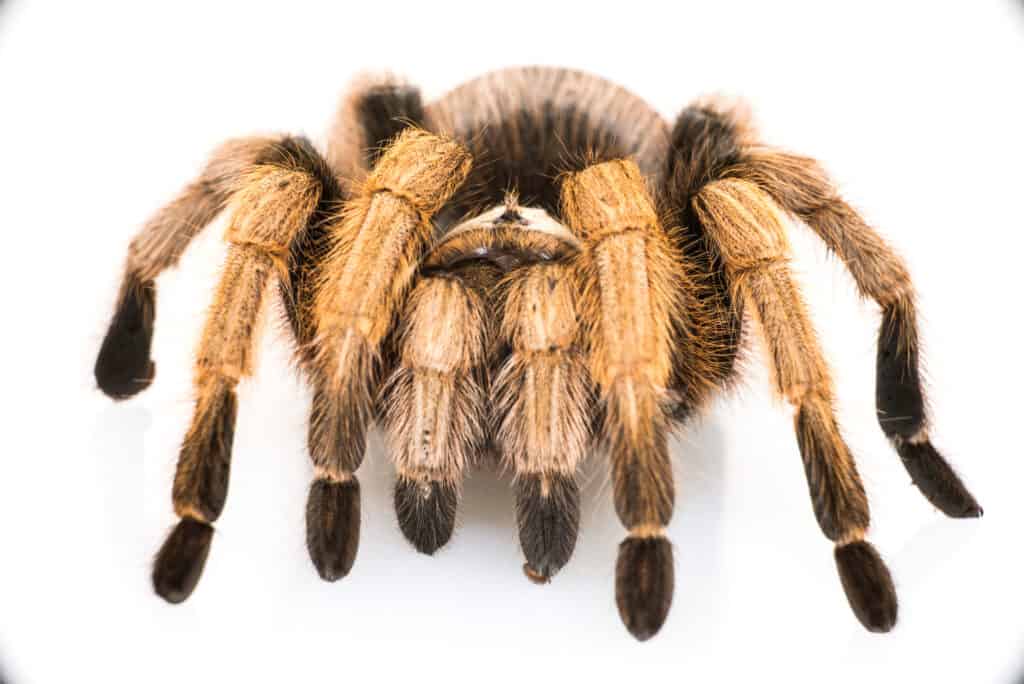
The Arizona blonde tarantula is small, measuring 3 to 4 inches.
©bloomphoto/Shutterstock.com
It is one of the smaller-sized tarantulas measuring 3 to 4 inches. However, they are still some of the largest in North America. You can identify them by their dark-colored chocolate bodies covered with blonde hair.
These tarantulas can survive two decades in captivity. They love to burrow holes and cover their entrance with a silk web.
Brazilian Pink Bird-Eating Tarantula
This tarantula measures 11 inches and is ranked the third largest tarantula in the world.
The species’ popularity has grown because of its docile nature, large size, and reproduction readiness.
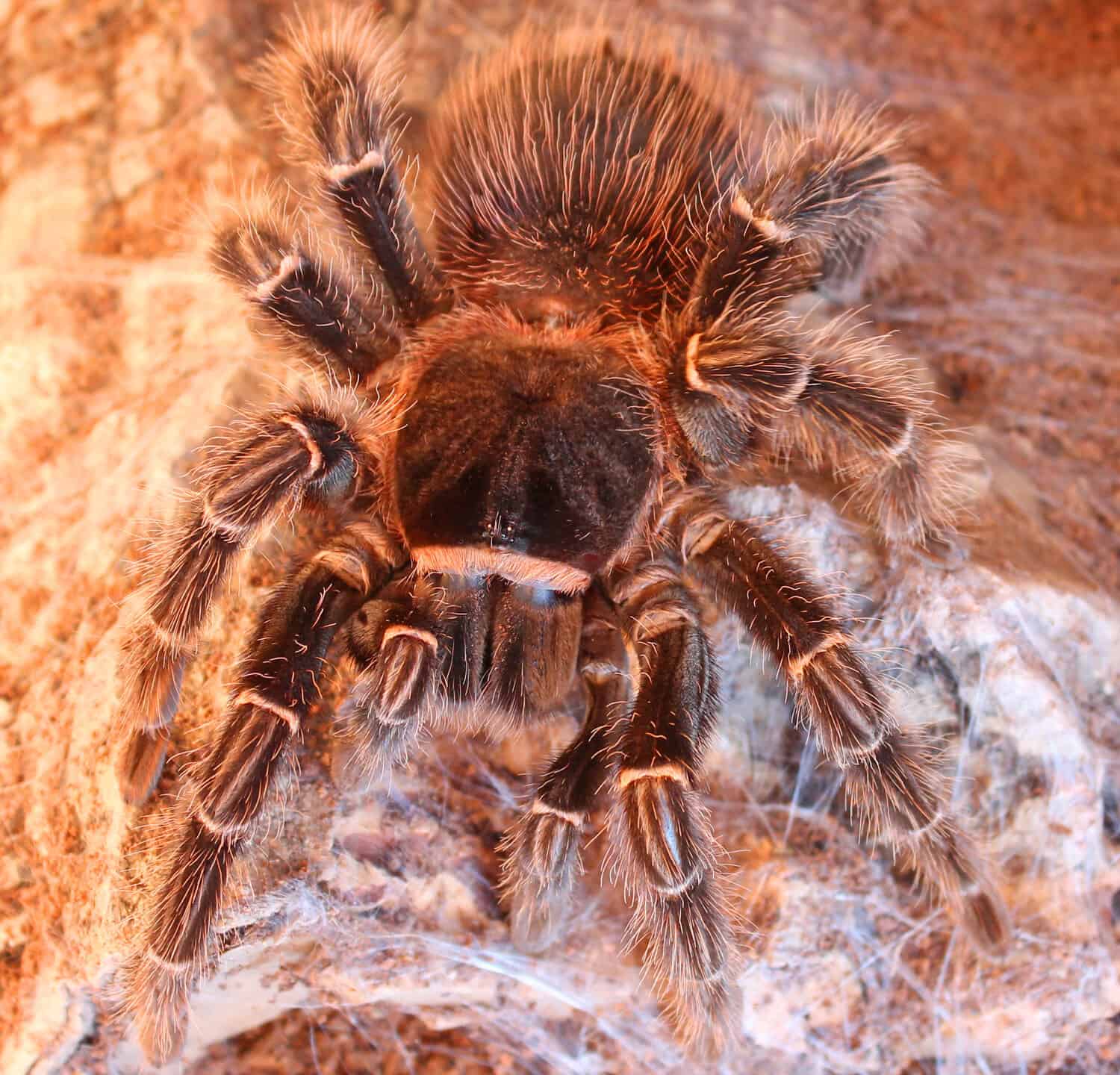
The Brazilian pink bird-eating tarantula is docile and mild.
©Giideon/Shutterstock.com
Most large-size tarantulas can be problematic to care for. However, the Brazilian pink bird-eating tarantula isn’t. They are docile and mild though they may attack when threatened. Their bite is not highly venomous, but due to their size, a bite can cause significant damage.
These tarantula species are terrestrial. This means that they burrow and hide underground. You can find them in the Brazilian tropical forest, where they feed on small birds, frogs, lizards, and insects. Their lifespan is about 12 to 15 years.
Skeleton Tarantula
This spider gets its name from its skeleton-like appearance, including white striped legs. It is found in South America and is very common in the Brazilian Amazon Forest. It also thrives in rainforests, humid grasslands, and French Guinea.
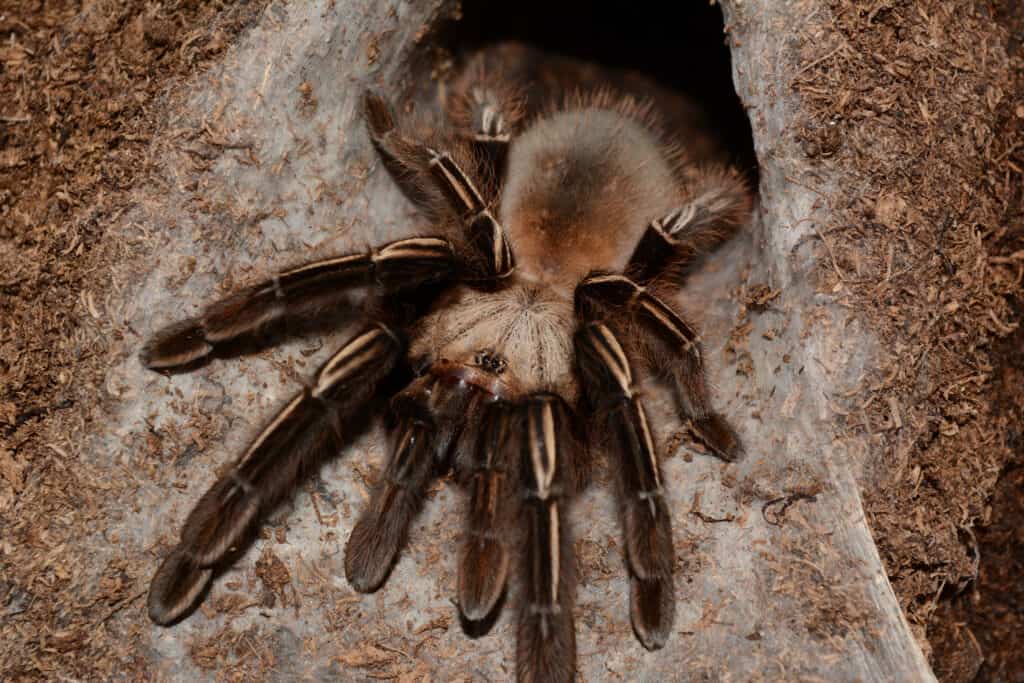
A skeleton tarantula can grow to about 4 to 5 inches.
©xtotha/Shutterstock.com
They are pretty easy to keep but require minimal handling. Skeleton tarantulas can withstand temperature and humidity variations too. Females can last up to 15 years, while males only live for three to four years.
As for the size, the skeleton tarantula is a medium-sized spider. They can grow to about 4 to 5 inches. Note that they are generally quick and aggressive. They will not hesitate to release irritating hairs in self-defense.
Honduran Curly Hair Tarantula
The Honduran curly-hair tarantula grows to a size of 5 to 6 inches. This classifies it among the large tarantula species. It is primarily brown or black with some gold, giving the curly hair a bronze sheen.

Honduran curly hair tarantulas are among the large tarantula species measuring 5 to 6 inches.
©1,600 × 1,200 pixels, file size: 346 KB, MIME type: image/jpeg – License
They are excellent picks for pets because they are calm. Because the Honduran curly-hair tarantula scares easily, it should be handled only when necessary. Females can live up to a decade. The species is native to Honduras and Costa Rica.
The Largest Tarantula Ever Recorded/Caught
The Goliath bird-eater spider is one of the largest tarantulas ever caught or recorded. This Theraphosa blondi was large enough to cover an entire dinner plate!
The Pablo San Martin expedition crew picked it up at Rio Cavro, Venezuela, in April 1965. The massive arachnid had an 11-inch leg span.

The Goliath bird eater measures 5.1 inches and weighs 62 ounces.
©juerginho/Shutterstock.com
This is one of the most fascinating spiders to date. It is both large and long, with the legs longer than the body. It is the largest and heaviest spider in the world.
Goliath tarantulas weigh about 62 ounces. Their body length can get up to 5.1 inches, while leg span measures about 11 inches. The combination of weight and body size makes them one of the most intimidating spiders globally.
Fortunately, these massive scary creatures are not dangerous to humans. Although they have fangs measuring 0.8 to 1.5 inches and are known to have venom, their bites are rarely harmful. Their sting is equated to that of a wasp.
Their name comes from the fact that the spider feeds on birds. However, this does not mean they depend entirely on birds to survive. Most tarantulas prefer eating lizards, insects, mice, and frogs.
Places you’re Most Likely to Encounter the Goliath Bird Eater Tarantula
The Goliath bird eater is a tarantula that is native to South America. You will spot it in the Amazon rainforest, swamps, or marshes. Other rainforest regions you can find this spider include:
- French Guiana
- Northern Brazil
- Guyana
- Venezuela
- Suriname
It is also possible to buy them as pets. However, they may cost a lot of money. This is because of the spider’s size and title of the world’s largest tarantula.
Unfortunately, most spider species and tarantulas have gotten a bad rep. Contrary to what many people assume, tarantulas are not dangerous. They may have venom, but most species’ bites are harmless.
When thrown, their hairs can irritate, but other than that, most tarantulas are safe. Remember not to handle them unnecessarily, lest they interpret it negatively and react.
Research the species you want to keep as a pet. Consider its size at maturity and other important factors that may affect care.
Summary of Tarantula Species and their Appropriate Sizes
| Species | Average Size |
|---|---|
| Goliath bird eater tarantula | 9-11 inches |
| Mexican red-knee spider | 5-8 inches |
| Chilean rose | 4-5 inches |
| Pink zebra beauty | 5.5 inches |
| Brazilian black | 7 inches |
| Arizona blonde tarantula | 3 -4 inches |
| Brazilian pink bird-eating tarantula | 11 inches |
| Skeleton tarantula | 4-5 inches |
| Honduran curly hair tarantula | 5-6 inches |
The photo featured at the top of this post is © Lauren Suryanata/Shutterstock.com
Thank you for reading! Have some feedback for us? Contact the AZ Animals editorial team.






